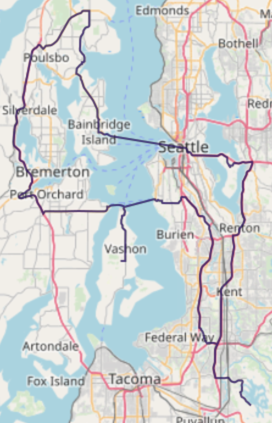Multiple Routing on Seattle Road Network
Solve graph with multiple destinations using a road network
Note
This documentation is for a prior release of Kinetica. For the latest documentation, click here.
Solve graph with multiple destinations using a road network
The following is a complete example, using the Python API, of solving a graph created with Seattle road network data for a multiple routing problem via the /solve/graph endpoint. For more information on Network Graphs & Solvers, see Network Graphs & Solvers Concepts.
The prerequisites for running the multiple routing solve graph example are listed below:
The native Kinetica Python API is accessible through the following means:
The Python package manager, pip, is required to install the API from PyPI.
Install the API:
| |
Test the installation:
| |
If Import Successful is displayed, the API has been installed as is ready for use.
In the desired directory, run the following, but be sure to replace <kinetica-version> with the name of the installed Kinetica version, e.g., v7.1:
| |
Change directory into the newly downloaded repository:
| |
In the root directory of the unzipped repository, install the Kinetica API:
| |
Test the installation (Python 2.7 (or greater) is necessary for running the API example):
| |
The example script references the road_weights.csv data file,
mentioned in the Prerequisites, in the current local directory, by default.
This directory can specified as a parameter when running the example script.
This example is going to demonstrate solving for the shortest possible route between destination points and a source point located in a Seattle road network.
Several constants are defined at the beginning of the script:
SCHEMA -- the name of the schema in which the tables supporting the graph creation and match operations will be created
Important
The schema is created during the table setup portion of the script because the schema must exist prior to creating the tables that will later support the graph creation and match operations.
TABLE_SRN -- the name of the table into which the Seattle road network dataset is loaded
GRAPH_S -- the Seattle road network graph
TABLE_GRAPH_S_MRSOLVED -- the solved Seattle road network graph using the MULTIPLE_ROUTING solver type
| |
One graph is used for the multiple routing solve graph example utilized in the script: seattle_road_network_graph, a graph based on the Seattle road network dataset (the CSV file mentioned in Prerequisites).
The seattle_road_network_graph graph is created with the following characteristics:
| |
Before the seattle_road_network_graph graph is solved, the source node and destination nodes are defined.
| |
Next, the graph is solved with the solve results being exported to the response:
| |
The cost for the source node to visit the destination nodes is represented as time in minutes:
| |
The solution output to WMS:

Included below is a complete example containing all the above requests, the data files, and output.
To run the complete sample, ensure that:
solve_graph_seattle_multi_route.py script is in the current
directoryroad_weights.csv file is in the current directory or use
the data_dir parameter to specify the local directory containing itThen, run the following:
| |